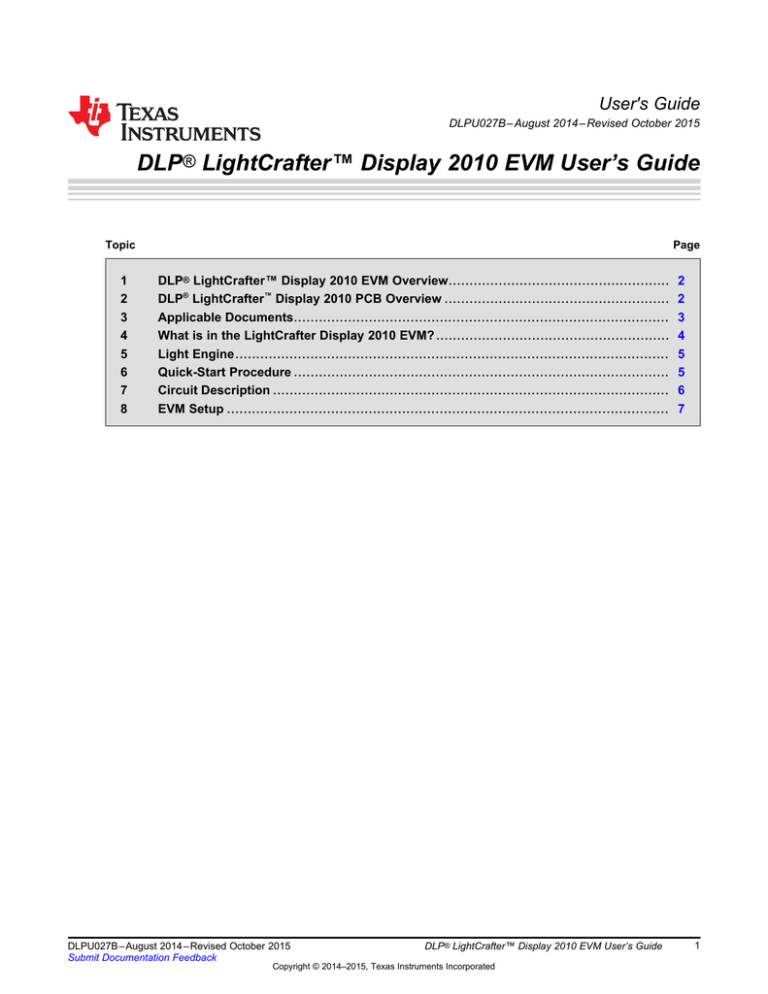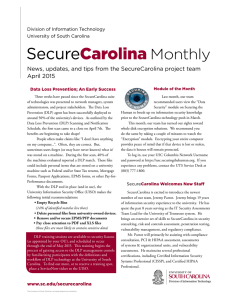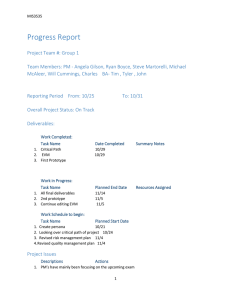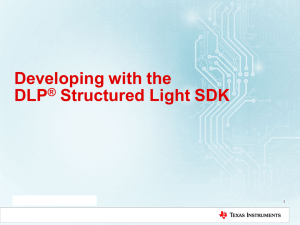DLP LightCrafter Display 2010 EVM User`s Guide
advertisement

User's Guide DLPU027B – August 2014 – Revised October 2015 DLP® LightCrafter™ Display 2010 EVM User’s Guide Topic 1 2 3 4 5 6 7 8 ........................................................................................................................... DLP® LightCrafter™ Display 2010 EVM Overview..................................................... DLP® LightCrafter™ Display 2010 PCB Overview ...................................................... Applicable Documents.......................................................................................... What is in the LightCrafter Display 2010 EVM? ........................................................ Light Engine ........................................................................................................ Quick-Start Procedure .......................................................................................... Circuit Description ............................................................................................... EVM Setup .......................................................................................................... DLPU027B – August 2014 – Revised October 2015 Submit Documentation Feedback DLP® LightCrafter™ Display 2010 EVM User’s Guide Copyright © 2014–2015, Texas Instruments Incorporated Page 2 2 3 4 5 5 6 7 1 DLP® LightCrafter™ Display 2010 EVM Overview 1 www.ti.com DLP® LightCrafter™ Display 2010 EVM Overview This user’s guide presents an overview of the DLP LightCrafter Display 2010 evaluation module (EVM) and a general description of the main features and functions. It will explain the first steps to get started, and provides a detailed description of the push buttons function, the on board LEDs, and the main connectors. It will give the user a successful start with his first DLP LightCrafter Display 2010 evaluation module. Figure 1. DLP LightCrafter Display complete EVM 2 DLP® LightCrafter™ Display 2010 PCB Overview DLPDLCR2010EVM-PCB is the PCB-only version of the DLP LightCrafter Display 2010 evaluation module (EVM). This EVM only includes the drive electronics for the DLP2010 DMD without any optical module. This EVM can be used for integrating your choice of DLP2010 DMD based optical module using proper flex cable for DMD interface and LED interface (please refer to the schematics for pinout and layout information). Typically the flash memory (which stores the firmware) is part of the optical engine, and therefore DLPDLCR2010EVM-PCB does not have the flash memory installed. If you would like to install the flash memory, please refer the DLPC3435 datasheet (DLPS038) for flash memory requirements and recommend flash memory. LightCrafter is a trademark of Texas Instruments. DLP is a registered trademark of Texas Instruments. 2 DLP® LightCrafter™ Display 2010 EVM User’s Guide DLPU027B – August 2014 – Revised October 2015 Submit Documentation Feedback Copyright © 2014–2015, Texas Instruments Incorporated Applicable Documents www.ti.com Figure 2. DLP LightCrafter Display PCB In addition to this document, the documents shown in Section 3 should be used. 3 Applicable Documents The following documents are applicable to the DLP LightCrafter Display 2010 EVM and are available at www.ti.com. • DLP2010 (0.2 WVGA) DMD data sheet (DLPS046) • DLPC3435 controller data sheet (DLPS038) • Software Programmer's Guide (DLPU020A) • DLP LightCrafter Display EVM GUI Tool User's Guide (DLPU021) For assistance, refer to the DLP and MEMS TI E2E community support forums. DLPU027B – August 2014 – Revised October 2015 Submit Documentation Feedback DLP® LightCrafter™ Display 2010 EVM User’s Guide Copyright © 2014–2015, Texas Instruments Incorporated 3 What is in the LightCrafter Display 2010 EVM? 4 www.ti.com What is in the LightCrafter Display 2010 EVM? The DLP LightCrafter Display module consists of three subsystems: • Light engine: includes the optics, red, green, and blue LEDs, and the 854 x 480 (WVGA) DMD. Capable of 25 lumens out-of-the-box. • Driver board: includes the DLP chipset comprising of DLPC3435 Controller and DLPA2005 PMIC/LED driver. • System board: includes MSP430, ITE HDMI receiver, USB-I2C bridge and several connectors for external inputs (HDMI, USB etc). CY7C65215 LED connection Flash Optical Engine DMD connection VLED (R/G/B) DLPA2005 1.1V 1.8V SYSPWR PROJ_ON BIAS, RST, OFS RESETZ SPI SPI_0 SPI_1 Flash I/F (4) CTRL Sub-LVDS DATA SPI USB-SPI Bridge Push Buttons USB PROJ_ON I2C MSP430 LED_SEL(2) DLPC3435 1.8V 1.1V I2C Parallel I/F 24 Bit Data CTRL TLV320DAC3101 Parallel I/F 24 Bit Data CTRL EE PROM IT6801 I2C 5V DV DAC HDMI Audio Out Figure 3. DLP LightCrafter Display EVM Block Diagram 4 DLP® LightCrafter™ Display 2010 EVM User’s Guide DLPU027B – August 2014 – Revised October 2015 Submit Documentation Feedback Copyright © 2014–2015, Texas Instruments Incorporated Light Engine www.ti.com 5 Light Engine The optical engine in the EVM is developed by Asia Optics and is production ready. The light engine consists of the following components: • 0.2-inch WVGA DMD (DLP2010) • OSRAM red, green and blue LED – LE BA Q6WM and LCG H9RM Table 1. Optical Engine Specifications PARAMETER MIN TYP MAX UNIT Brightness 25 Lum LED Current 650 mA Brightness Uniformity 75% Throw Ratio 1.65 Offset 100% Focus Range 5 50 inch Image Diagonal Size 5 50 inch The dimensions of the optical engine are shown in Figure 4: Figure 4. Dimensions of Optical Engine 6 Quick-Start Procedure This quick-start assumes default conditions as shipped. 1. Power up the DLP LightCrafter™ Display 2010 EVM by applying an external DC power supply (5-V DC, 3.0 A) to the J12 connector. • Note: Use an AC-DC switching power supply which accepts 50-60Hz 100-240VAC inputs, and outputs a nominal 5 VDC at maximum 3-A output current. The PWRON (D16) and SYSPWR (D15) LED will turn on to indicate that 5-V power is applied. 2. Move the SW_ONOFF switch to the ON position to turn the DLP LightCrafter™ Display 2010 EVM on. When the LightCrafter™ Display 2010 EVM is turned on, the PROJ_ON LED will turn on. DLPU027B – August 2014 – Revised October 2015 Submit Documentation Feedback DLP® LightCrafter™ Display 2010 EVM User’s Guide Copyright © 2014–2015, Texas Instruments Incorporated 5 Circuit Description www.ti.com 3. After the DLP LightCrafter™ Display 2010 EVM is turned on; the projector will default to displaying a DLP LightCrafter™ Display splash image. 4. The focus of the image can be adjusted with the focus wheel on the optical engine. Focus wheel Figure 5. Optical Engine with Focus Wheel 5. Connect USB to the LightCrafter Display 2010 EVM and open the GUI on your Computer. If needed, connect an HDMI source to the EVM and communicate to the EVM over the GUI software. 6. When turning off the projector, turn off the SW_ONOFF switch prior to removing power cable. Note: To avoid potential damage to the DMD, it is recommended to turn off the projector with the SW_ONOFF before disconnecting the power. 7. There are ten indicator LEDs on the DLP LightCrafter™ Display 2010 EVM ( Table 2): Table 2. LEDs on the DLP LightCrafter Display 2010 EVM D15 SYSPWR 5-V Power applied D16 PWRON Regulated 3V3 power on D7 PROJ_ON D6 RESETZ D5 HOST_IRQ D9 MSP2 D8 ACK ON when Cypress CY3420 is I2C master OFF when MSP430 is I2C master D10 REQ ON when Cypress CY3420 requests the MSP430 to give Cypress master control of the I2C bus D12 GPIO1 Blinking when PC is communicating to flash over SPI D14 GPIO0 Blinking when PC is communicating to DLPC3435 over I2C On when Projector is turned on via SW_ONOFF OFF when Projector is turned on vie SW_ONOFF ON during DLPC3435 boot OFF when projector is running. Indication of DLPC3435 boot-up completed and ready to receive commands ON when HDMI cable plugged in and external video detected. OFF when external video is not detected. 7 Circuit Description 7.1 Connectors, Switch and Push buttons on Main Board Table 3. List of Installed Connectors on the Main board 6 INSTALLED CONNECTORS/HEADERS DESCRIPTION J12 Connector for 5-V external power supply interface J7 Connector for USB cable J2 Connector for Audio J4 Connector for HDMI input J1 MSP430 JTAG Programming interface connector J13 Connector for the I2C interface (DevaSys box) DLP® LightCrafter™ Display 2010 EVM User’s Guide DLPU027B – August 2014 – Revised October 2015 Submit Documentation Feedback Copyright © 2014–2015, Texas Instruments Incorporated Circuit Description www.ti.com Table 3. List of Installed Connectors on the Main board (continued) INSTALLED CONNECTORS/HEADERS DESCRIPTION J6 60 pin connector for DLP LightCrafter Display board J10 Header for 5-V DC power J11 Header for 5-V DC power J3 Unsupported J5 Unsupported Table 4. List of Installed Push Buttons and Switch on Main Board INSTALLED SWITCHES/PUSH BUTTONS DESCRIPTION SW1 Projector On/OFF Switch Source Selection • First press: TPG • Second press: HDMI input • Third press: Splash screen PB-UP1 PB-SEL1 7.2 Cycle through displaying 7 curtain colors PB-DOWN1 Flip image N/S or E/W PB_LEFT1 Cycle 9 different TPG patterns after TPG source selected Cycle 4 different Splash screens after Splash source selected Change of Volume when HDMI input is selected PB_RIGHT1 Change LED current total 7 steps Change of Volume when HDMI input is selected Connectors on DLP LightCrafter™ Display board Table 5. List of Installed Connectors on the DLP LightCrafter™ Display Board 8 INSTALLED SWITCHES/PUSH BUTTONS DESCRIPTION J1 Connector for the DMD flex cable J2 Connector for LED cable J3 Connector for external temperature sensor (Requires removing R21) J4 Connector for light sensor J5 Future use J6 60 pin connector for DLP LightCrafter Display board EVM Setup The DLP LightCrafter™ Display 2010 EVM is composed of three parts: • Main board • DLP LightCrafter Display board • Engine with LED connection and Flex cable The main board contains the connector for the power supply, the USB connector to communicate to the DLP LightCrafter Display software, the HDMI, audio and the connector for the DLP LightCrafter Display board. The main board also contains the switch to turn on the projector in case the DLP LightCrafter Display board and the engine is connected. Figure 6 shows the main connectors on the main board. DLPU027B – August 2014 – Revised October 2015 Submit Documentation Feedback DLP® LightCrafter™ Display 2010 EVM User’s Guide Copyright © 2014–2015, Texas Instruments Incorporated 7 EVM Setup www.ti.com Audio interface HDMI connector Projector ON/OFF switch 5 V power connector DLP LightCrafter Display board connector USB connector Figure 6. DLP LightCrafter Display main board The DLP LightCrafter Display board has three main connectors: the LED connector, the Flex cable connector, and the main board connector. To connect the main board to the DLP LightCrafter Display board, refer to Figure 7. Note that the main board connector on the DLP LightCrafter™ Display board is on the bottom while the LED and Flex cable connectors are on the top. Figure 7. Connection Main Board and DLP LightCrafter Display board The board itself and how it gets connected to the main board is shown in Figure 8 8 DLP® LightCrafter™ Display 2010 EVM User’s Guide DLPU027B – August 2014 – Revised October 2015 Submit Documentation Feedback Copyright © 2014–2015, Texas Instruments Incorporated EVM Setup www.ti.com LED connector Flex cable connector Figure 8. DLP LightCrafter Display To engine will need a total of four connections: two are from the Flex cable (one for the DMD and the other for the flash card mounted on the engine) and two that come from a small adapter board that ensure communication with the LEDs. Refer to Figure 9 to see the proper setup. The pins of the flex cable connector are labeled with the pin numbers, verify that the pin numbers matches when connecting the flex cable. To ensure the LED cables are connected correctly, use the colored circles to trace each cable to the right connection. Once again, verify that the connection is as shown in Figure 9. DMD DMD connector con Flash card Flas connector con Figure 9. LED Connection and Flex Cable Connection Figure 10 shows the final setup of all parts. DLPU027B – August 2014 – Revised October 2015 Submit Documentation Feedback DLP® LightCrafter™ Display 2010 EVM User’s Guide Copyright © 2014–2015, Texas Instruments Incorporated 9 EVM Setup www.ti.com Figure 10. DLP LightCrafter Display complete EVM Make sure that everything is setup correctly before continuing. Verify that the flex cable is connected correctly to the DMD and the LightCrafter Display board. 10 DLP® LightCrafter™ Display 2010 EVM User’s Guide DLPU027B – August 2014 – Revised October 2015 Submit Documentation Feedback Copyright © 2014–2015, Texas Instruments Incorporated Revision History www.ti.com Revision History Changes from A Revision (October 2014) to B Revision ............................................................................................... Page • Added DLP Lightcrafter Display 2010 PCB Overview section ...................................................................... 2 NOTE: Page numbers for previous revisions may differ from page numbers in the current version. DLPU027B – August 2014 – Revised October 2015 Submit Documentation Feedback Copyright © 2014–2015, Texas Instruments Incorporated Revision History 11 IMPORTANT NOTICE Texas Instruments Incorporated and its subsidiaries (TI) reserve the right to make corrections, enhancements, improvements and other changes to its semiconductor products and services per JESD46, latest issue, and to discontinue any product or service per JESD48, latest issue. Buyers should obtain the latest relevant information before placing orders and should verify that such information is current and complete. All semiconductor products (also referred to herein as “components”) are sold subject to TI’s terms and conditions of sale supplied at the time of order acknowledgment. TI warrants performance of its components to the specifications applicable at the time of sale, in accordance with the warranty in TI’s terms and conditions of sale of semiconductor products. Testing and other quality control techniques are used to the extent TI deems necessary to support this warranty. Except where mandated by applicable law, testing of all parameters of each component is not necessarily performed. TI assumes no liability for applications assistance or the design of Buyers’ products. Buyers are responsible for their products and applications using TI components. To minimize the risks associated with Buyers’ products and applications, Buyers should provide adequate design and operating safeguards. TI does not warrant or represent that any license, either express or implied, is granted under any patent right, copyright, mask work right, or other intellectual property right relating to any combination, machine, or process in which TI components or services are used. Information published by TI regarding third-party products or services does not constitute a license to use such products or services or a warranty or endorsement thereof. Use of such information may require a license from a third party under the patents or other intellectual property of the third party, or a license from TI under the patents or other intellectual property of TI. Reproduction of significant portions of TI information in TI data books or data sheets is permissible only if reproduction is without alteration and is accompanied by all associated warranties, conditions, limitations, and notices. TI is not responsible or liable for such altered documentation. Information of third parties may be subject to additional restrictions. Resale of TI components or services with statements different from or beyond the parameters stated by TI for that component or service voids all express and any implied warranties for the associated TI component or service and is an unfair and deceptive business practice. TI is not responsible or liable for any such statements. Buyer acknowledges and agrees that it is solely responsible for compliance with all legal, regulatory and safety-related requirements concerning its products, and any use of TI components in its applications, notwithstanding any applications-related information or support that may be provided by TI. Buyer represents and agrees that it has all the necessary expertise to create and implement safeguards which anticipate dangerous consequences of failures, monitor failures and their consequences, lessen the likelihood of failures that might cause harm and take appropriate remedial actions. Buyer will fully indemnify TI and its representatives against any damages arising out of the use of any TI components in safety-critical applications. In some cases, TI components may be promoted specifically to facilitate safety-related applications. With such components, TI’s goal is to help enable customers to design and create their own end-product solutions that meet applicable functional safety standards and requirements. Nonetheless, such components are subject to these terms. No TI components are authorized for use in FDA Class III (or similar life-critical medical equipment) unless authorized officers of the parties have executed a special agreement specifically governing such use. Only those TI components which TI has specifically designated as military grade or “enhanced plastic” are designed and intended for use in military/aerospace applications or environments. Buyer acknowledges and agrees that any military or aerospace use of TI components which have not been so designated is solely at the Buyer's risk, and that Buyer is solely responsible for compliance with all legal and regulatory requirements in connection with such use. TI has specifically designated certain components as meeting ISO/TS16949 requirements, mainly for automotive use. In any case of use of non-designated products, TI will not be responsible for any failure to meet ISO/TS16949. Products Applications Audio www.ti.com/audio Automotive and Transportation www.ti.com/automotive Amplifiers amplifier.ti.com Communications and Telecom www.ti.com/communications Data Converters dataconverter.ti.com Computers and Peripherals www.ti.com/computers DLP® Products www.dlp.com Consumer Electronics www.ti.com/consumer-apps DSP dsp.ti.com Energy and Lighting www.ti.com/energy Clocks and Timers www.ti.com/clocks Industrial www.ti.com/industrial Interface interface.ti.com Medical www.ti.com/medical Logic logic.ti.com Security www.ti.com/security Power Mgmt power.ti.com Space, Avionics and Defense www.ti.com/space-avionics-defense Microcontrollers microcontroller.ti.com Video and Imaging www.ti.com/video RFID www.ti-rfid.com OMAP Applications Processors www.ti.com/omap TI E2E Community e2e.ti.com Wireless Connectivity www.ti.com/wirelessconnectivity Mailing Address: Texas Instruments, Post Office Box 655303, Dallas, Texas 75265 Copyright © 2015, Texas Instruments Incorporated





